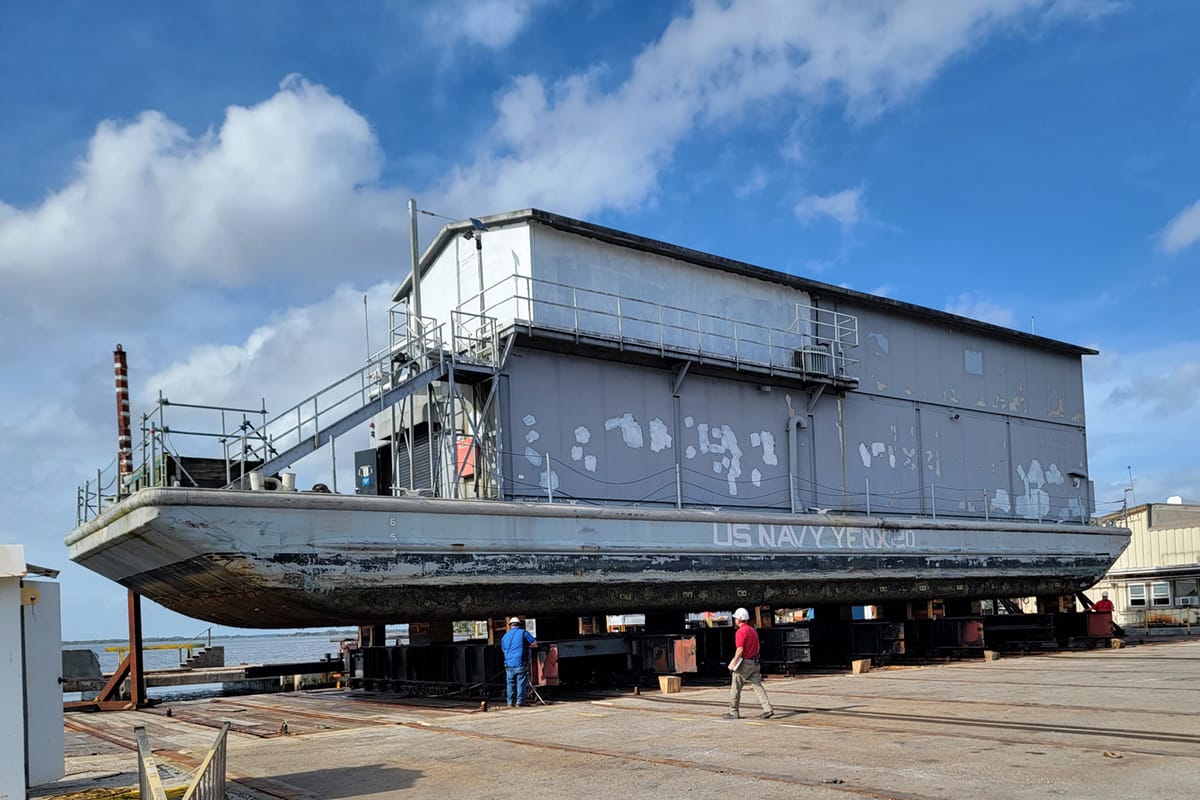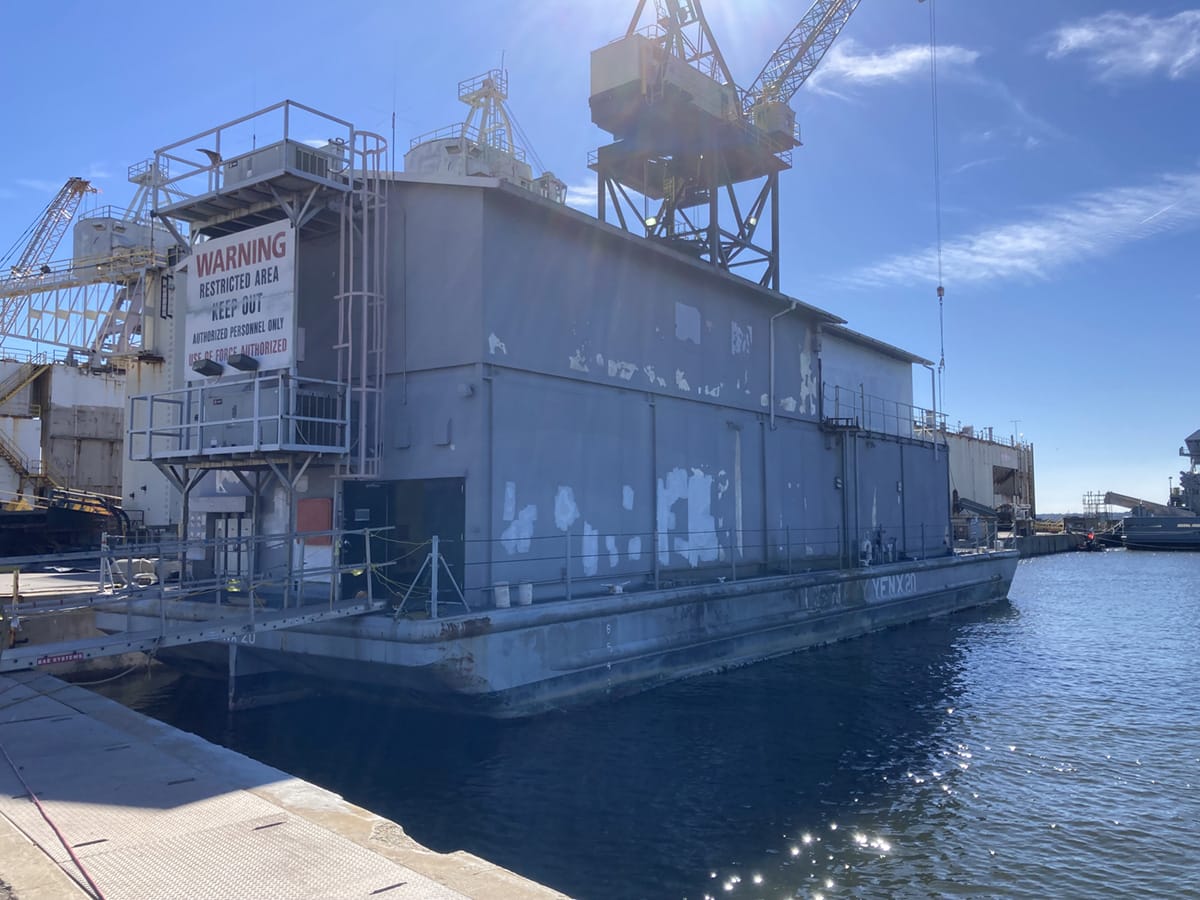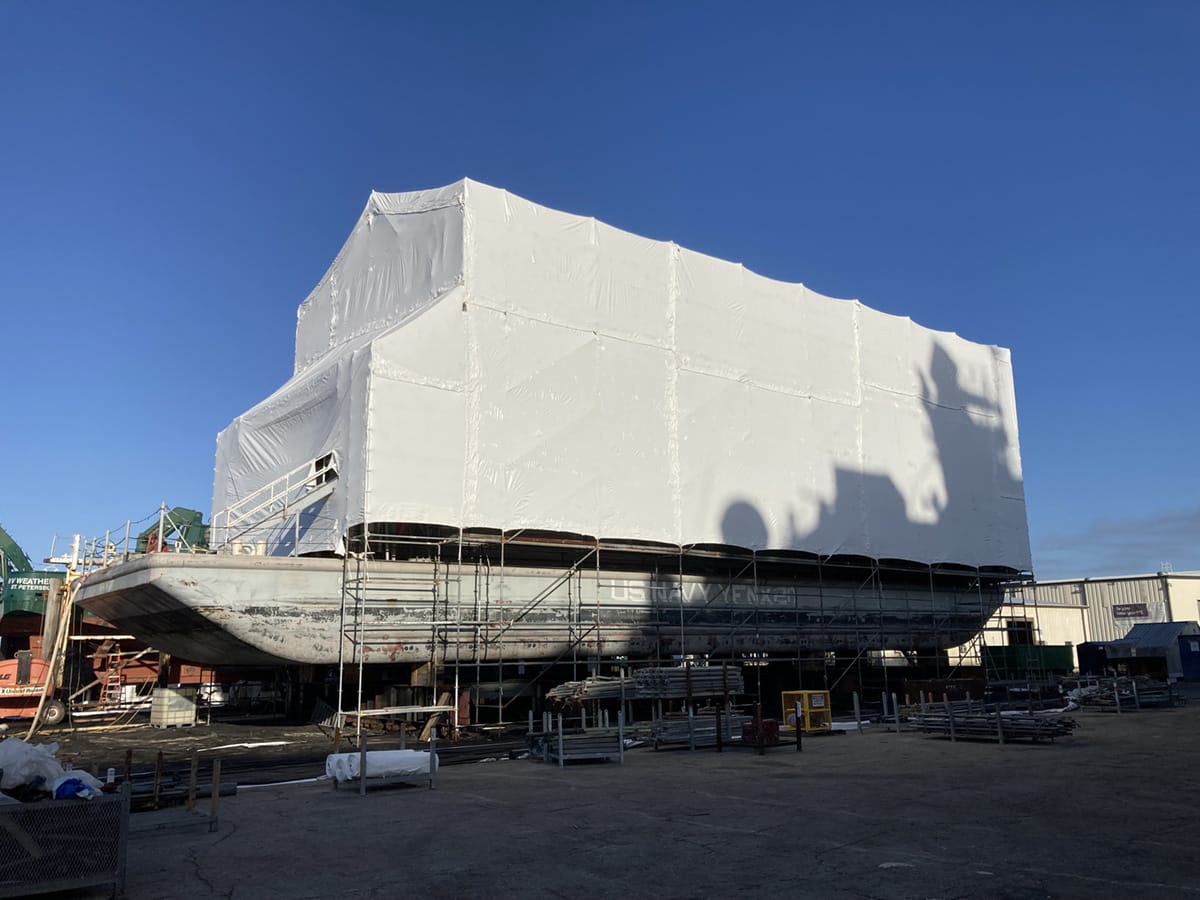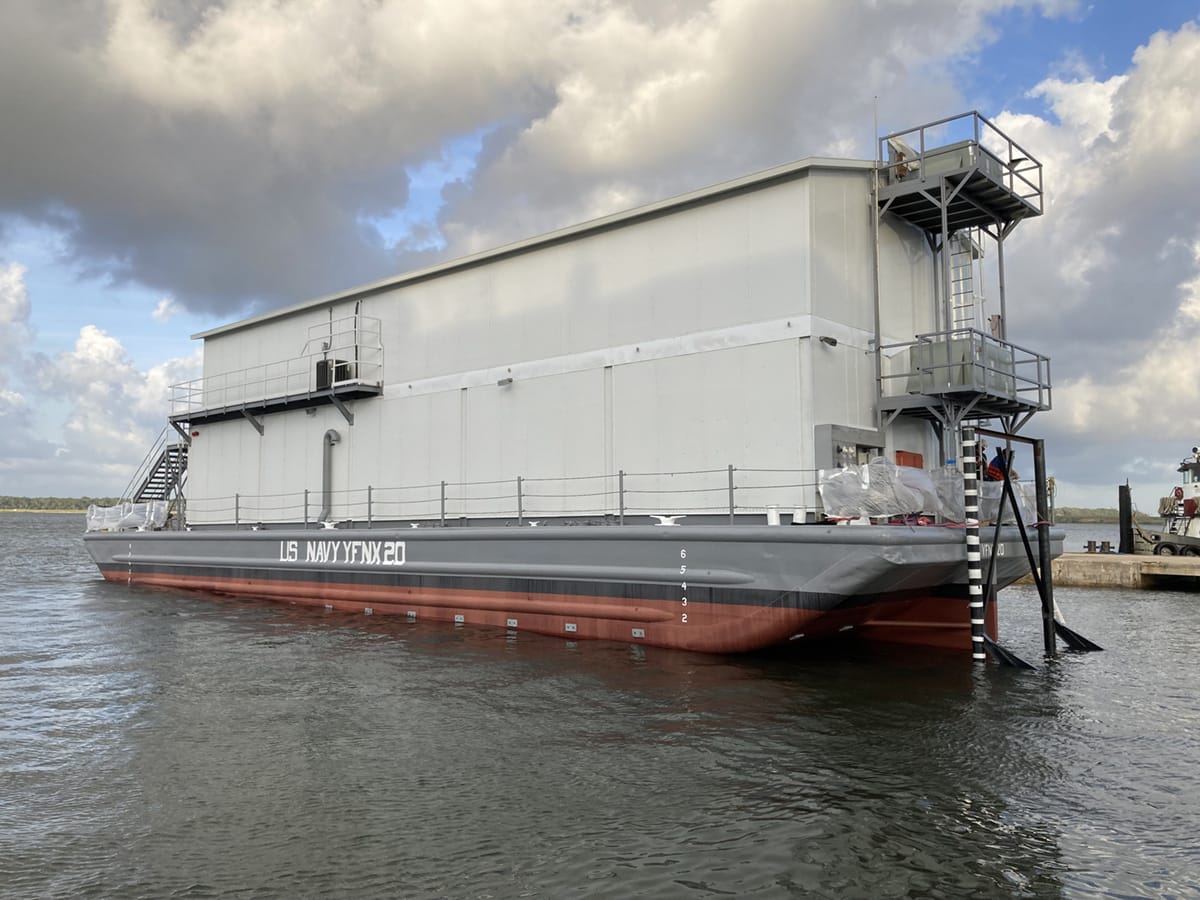Panel Replacement Adds Years to Life of Navy Vessel
Panel Built, Inc. (PBI), a portable building manufacturer in Blairsville, Georgia, recently replaced all the wall and roof panels on a two-story US Navy barge deck house that the company had originally installed 30 years ago, giving the vessel new life. The structure, which is used for storage and office space while the barge is docked in Charleston, South Carolina, was in pretty sad shape, patches and repairs giving it a rough look, but it was standing. Now, the commanding officer of the unit that uses the barge said the difference between the condition and appearance from when the barge left their facility to when the project was complete was beyond his expectations of what was possible.

The U.S. Navy worked with Panel Built, Inc. to rebuild a sea-worn two-story deck house barge.
An Unusual Project from the Beginning
Mark Ledger, project manager for BAE Systems Jacksonville Ship Repair, a defense contractor that works on both commercial and military ships, said the project started when they won the contract to perform about 25 maintenance items on a Navy barge, and one of the tasks was to replace the existing deck house structure. “We weren’t familiar with the products or the process because we hadn’t done something specifically like that before,” said Ledger. “We were having difficulty finding sources for the material, so we asked the government, ‘do you have any reference for other companies that have worked on this sort of thing before?’ They recommended Panel Built because, based on the existing design documents, they were the company that constructed the original deck house.”
Eliyah Ryals, outside sales representative for Panel Built, said they didn’t understand the extent of the project until they saw the barge for themselves. “Once we got down to the site,” Ryals said, “we noticed the deck house structure had been through the ringer, you could say. It had been painted over multiple times and was deteriorating due to exposure to the sea. Some panels were in better shape than others, but the whole thing was in pretty bad shape. So, we proposed replacing every panel, the roof, the entire project, basically.”
The original deck house structure had been built and designed by PBI co-founder Michael Tiernan, so the team was able to find the original design documents and work from them. However, with code changes and higher engineering requirements, additional structural elements, including 4,500 pounds of new I-beams and tubular steel, were needed to meet the extreme wind load requirements in Charleston.



A Multitude of Challenges
Ledger said, “the primary design concern and focus was the wind loads. PBI performed a design study to ensure that the modifications made to the structural supports for the walls and roof would withstand those wind loads.” The materials had to be designed to stand up to sea water, salt air, extreme heat, sunlight, humidity, and the occasional hurricane.
Another concern was the weight of the additional elements. “We needed to know the approximate weight of the materials coming off the barge,” said Ledger. “With new materials and construction techniques, some of the additional elements were lighter and some were heavier. We had to calculate the overall weight increase to make sure it wasn’t going to be significant enough to affect the stability of the vessel.”
Because all the walls and roof panels were going to be removed and replaced, BAE constructed an enclosure to keep the space as dry as possible during the construction process. A plastic skin was wrapped around scaffolding to protect all sides of the structure. This made setting panels and getting materials to the barge very difficult, as the plastic had to be moved or removed temporarily while the panels or materials were being set, then closed up again once they are in place. “Because the structural steel was so large and heavy, we had to crane those pieces in through the roof of the containment and then replace it,” said Ledger. “For the roof and wall panels that Panel Built provided, we were able to use articulated forklifts to raise and lower the materials in and out.” Luckily the work was performed in Jacksonville, Florida, so the weather wasn’t much of a factor.
PBI also had to ensure that the structure was sealed properly to prevent leaks and moisture intrusion. “We have buildings all over the US and the world that get rained on and that’s pretty normal for buildings. But with this structure actually sitting on the water on the coast of Charleston, we definitely had to seal it up a lot tighter than usual.”

The refurbished barge was delivered to the Navy in June 2024, ready to serve again.
The Navy requested the same panel finishes as the initial installation, but they were no longer available. “The original building panels had a honeycomb core, which nobody builds anymore, so we had to switch it to a polystyrene core with an aluminum finish, for protection from sea water and rust,” said Ryals.
This project was definitely unusual for Panel Built. Ryals said, “I don’t think anybody really does a bunch of modular buildings on a barge on a normal basis.”
PBI shipped over 120 4’x10’ and 4’x12’ panels in just over four weeks from contract to delivery. The process ran smoothly, and installation was completed without any major issues. The panels come with a ten-year warranty, but Ryals said he wouldn’t be surprised if they lasted another 30 years.
Lessons Learned
Ledger calls the project a “great learning experience” and believes that it will help them in future work. “Some of the lessons learned involve how to disassemble and reassemble these types of modular construction components. We didn’t have much experience with these panels in the past. We have trades here in the shipyard that do similar things, but not with these kinds of materials. It was adapting an existing skillset to a new application. Now, instead of welding steel plate or fabricating something out of sheet metal, if we see that having a prefabricated structure like this would be a better alternative, then this gives us the ability to recognize that.”
Ryals said that while their team was a little leery of the project at the beginning, because of the high potential for something to go wrong, he is glad they took a chance on it because the product is performing well. “This was something that no other company wanted to tackle because they knew the risk. But all in all, it worked out.” He encourages those seeking similar work to contact PBI. “We’ve done it multiple times, so we’re well tooled to do it.”
The barge was delivered to the Navy at the end of June 2024. Here’s hoping the deck house lasts for another 30 years.
About the Author: Dawn Killough is a freelance construction writer with over 25 years of experience working with construction companies, subcontractors and general contractors. Her published work can be found at dkilloughwriter.com.
More from Modular Advantage
Resia: Breaking All the Rules
Resia Manufacturing, a division of U.S.-based Resia, is now offering prefabricated bathroom and kitchen components to industry partners. Its hybrid fabrication facility produces more precise bathroom and kitchen components (modules) faster and at lower cost than traditional construction. Here’s how Resia Manufacturing does it.
How LINQ Modular Innovates to Bring Modular To The Market in the UAE and Beyond
LINQ Modular, with an office and three manufacturing facilities in Dubai, is a modular firm based in United Arab Emirates. The company is on a mission: to break open the housing and construction markets in the Gulf Cooperation Council (GCC) area with modular.
ModMax: Redefining Modular Construction with Confidence and Precision
ModMax was born out of frustration—frustration with five persistent pain points in modular construction: Permitting bottlenecks. Production delays. Rigid designs. Disconnect between “the office” and the field. Lack of transparency and communication.
LifeArk: Disaster-Resilient Housing from Recycled Plastic and 100-year-old Technology
Wee compares LifeArk’s housing units to Yeti coolers, as they are built similarly. Each component takes 15 to 20 minutes to manufacture, has an R-value of 40, and includes molded slots and chases for wiring, plumbing, fire sprinklers, and other utilities.
Building the Future of Modular Edge Infrastructure
The edge data center market is expanding rapidly, driven by the surge in AI workloads, IoT adoption, and the need for localized compute power. In these environments, sustainability, scalability, and reliability are non-negotiable. Cooling is among the most complex challenges for operators—and one of the most decisive factors in long-term success.
Accelerating Light-Gauge Steel Construction: A Semi-Automated Digital Workflow for Off-Site Projects
For construction professionals, the message is clear. By adopting semi-automation and digitalization, companies can deliver projects faster, more accurately, and more profitably, while also building stronger collaboration across teams. The approach is not about replacing people with machines, but about empowering people with better tools and processes.
Why Modular Data Centers Are Gaining Momentum
Artificial intelligence, high-performance computing, and edge applications push the limits of traditional “stick-built” data centers. They take years build, often struggle with high density workloads, and aren’t optimized for deployments near end users. Modular data center platforms are purpose-built to address these challenges, offering flexibility and scalability to adapt to evolving technologies, while opening new opportunities for the modular construction industry.
Supply Chain Innovation in Action: 5 Habits Every Modular Leader Should Practice
By applying these principles to supply chain practices — collaborative planning, strategic procurement, scenario modeling, digital tools, and transparent forecasting — construction leaders can build value chains that are not just efficient and agile, but truly innovative.
Exploring the Role of Modular Integrated Construction (MiC) in Advancing Circular City Principles – A Survey of Stakeholder Perspectives
The survey findings highlight the significant potential of Modular integrated Construction (MiC) in advancing the development of circular cities. By reducing costs, accelerating construction timelines, and minimizing waste generation, MiC offers a promising approach to sustainable urban development.
The Use of MS POLYMER™-Based Sealants and Adhesives in Modular Building
These products combine flexibility and elastic recovery with excellent adhesion to different substrates and have already shown their usefulness in traditional construction. Now it’s time for them to be put to use in the modular construction industry.










